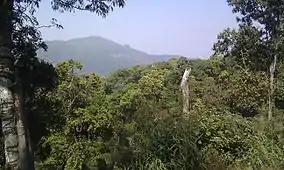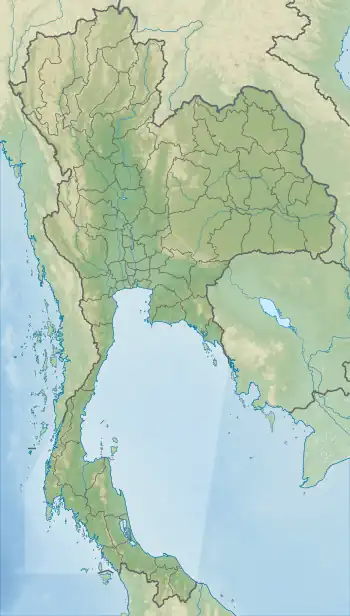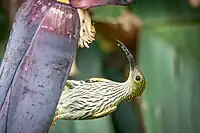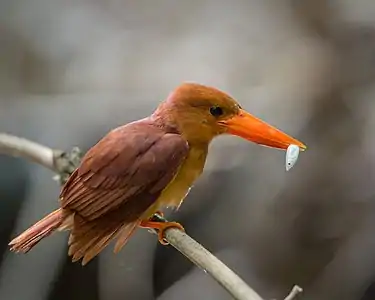| Kaeng Krachan National Park อุทยานแห่งชาติแก่งกระจาน | |
|---|---|
 | |
 Map of Thailand | |
| Location | Phetchaburi and Prachuap Khiri Khan Provinces, Thailand |
| Nearest city | Phetchaburi |
| Coordinates | 12°47′56″N 99°27′12″E / 12.79889°N 99.45333°E |
| Area | 2,915 km2 (1,125 sq mi) |
| Established | 12 June 1981 |
| Visitors | 103,510 (in 2019) |
| Governing body | Department of National Parks, Wildlife and Plant Conservation |
| Type | Natural |
| Criteria | X |
| Designated | 2021 |
| Part of | Kaeng Krachan Forest Complex |
| Reference no. | 1461 |
| Region | Asia-Pacific |
Kaeng Krachan National Park (Thai: อุทยานแห่งชาติแก่งกระจาน, RTGS: Utthayan Haeng Chat Kaeng Krachan, pronounced [ʔùt.tʰā.jāːn hɛ̀ŋ t͡ɕʰâːt kɛ̀ŋ krā.t͡ɕāːn]) is the largest national park of Thailand.[1][2] It is on the border with Burma, contiguous with the Tanintharyi Nature Reserve. It is a popular park owing to its proximity to the tourist town of Hua Hin. It was named a UNESCO World Heritage Site on 26 July 2021,[3][4] despite concerns from the OHCHR around the human rights violations of the indigenous people that live in the park.[5]
Geography

The park covers parts of the districts Nong Ya Plong, Kaeng Krachan, and Tha Yang of Phetchaburi Province, and of Hua Hin of Prachuap Khiri Khan Province. It consists mainly of rain forest on the eastern slope of the Tenasserim Mountain Range. The highest elevation in the park is 1,513 meters, in a "joint area of Thailand and Myanmar". The second highest mountain peak is Kao Panern Toong with an elevation of 1,207 m.[2] Two main rivers originate within the park area, the Pranburi River and the Phetchaburi River. The Phetchaburi is impounded by the Kaeng Krachan Dam at the eastern border of the park. The dam creates a lake covering an area of 46.5 km2. The dam was built in 1966.
History
The park was declared a reserve in 1964 and on 12 June 1981 it became the 28th national park of Thailand. Originally covering an area of 1,548,750 rai ~ 2,478 square kilometres (957 sq mi), it was enlarged in December 1984 to include the boundary area between Phetchaburi and Prachuap Khiri Khan Provinces, an additional 273,125 rai ~ 437 square kilometres (169 sq mi).[6] The park has been included on the list of ASEAN Heritage Parks. It is part of the Kaeng Krachan Forest Complex, which the Thai government had repeatedly nominated for designation as a World Heritage Site since 2011. At its 2019 meeting, UNESCO's World Heritage Committee (WHC) rejected Thailand's third bid, citing outdated information regarding boundaries and a lack of local community participation.[7] In July 2021 Thailand made its fourth application for World Heritage Site recognition.[8] On 26 July 2021, the 21 nations of the UNESCO World Heritage Committee voted 12–9 to approve Kaeng Krachan's listing as a World Heritage Site.[3]
The killing of wild elephants is an ongoing problem at the park,[9] with authorities unable to control poachers.[10] Some park officials are allegedly involved in the trade of elephant parts.[11]
Despite national park status, there are private plantations within the confines of Kaeng Krachan National Park. Some of these are surrounded by electric fences which, in June 2013, fatally electrocuted an elephant calf.[12]
In 2018, the park started taking bids on a project to pave 18.5 kilometres of the Bang Krang to Phanoen Thung Road. It is budgeted at 87.62 million baht. The existing one-lane dirt road is "broken beyond repair" according to the park's chief. Environmentalists oppose the project on the grounds that easier accessibility will mean more tourists in the fragile ecosystem.[13] The park chief says, "...the project does not violate regulations...and [we have] a duty...to proceed with the project."[14] The project was halted, at least temporarily, in early-November 2018 by the National Parks Department to allow opponents to be heard on the issue.[15][16]
Flora and fauna
The forests contain a great biodiversity of tropical vegetation, including tropical and subtropical broad leaf tree species and palms. Ninety-one species of mammals and 461 bird species have been counted in the park.[1][17]
 Martes flavigula, yellow-throated marten
Martes flavigula, yellow-throated marten Trachypithecus obscurus, dusky leaf monkey
Trachypithecus obscurus, dusky leaf monkey Arachnothera magna, streaked spiderhunter
Arachnothera magna, streaked spiderhunter Pycnonotus flavescens, flavescent bulbul
Pycnonotus flavescens, flavescent bulbul Halcyon coromanda, ruddy kingfisher
Halcyon coromanda, ruddy kingfisher
Wild fruits
The following wild fruits are found in Kaeng Krachan National Park.[18]
- Abutilon hirtum
- Actephila excetsa
- Actephita ovatis
- Adenanthera pavonina
- Afgekia filipes
- Aglaia edulis
- Aglaia lawii
- Aglaia odoratissima
- Aglaonema ovatum
- Alangium kurzii
- Aistonia rostrata
- Amalocalyx microlobus
- Ampelocissus martinii
- Antheroporum glaucum
- Antidesma ghaesembilla
- Aporosa villosa
- Archidendron jiringa
- Argyreia roseopurpurea
- Artabotrys burmanicus
- Artocarpus lacucha
- Aspidopterys tomentosa
- Balakata baccata
- Bauhinia ornata
- Beilschmiedia glauca
- Benkara sinensis
- Breynia retusa
- Bridelia insulana
- Buxus cochinchinensis
- Byttneria andamanensis
- Calamus longlsetus
- Capparis zeylanica
- Castanopsis armata
- Castanopsis echidnocarpa
- Catunaregam spathulifolia
- Catunaregam tomentosa
- Ceriscoides mamillata
- Cleistanthus hirsutulus
- Clerodendrum glandulosum
- Clerodendrum infortunatum
- Cnestis palala
- Codonopsis lancifolia
- Colona auricutata
- Croton caudatus
- Dichapetalum longipetalum
- Dillenia indica
- Diospyros apiculata
- Diospyros glandulosa
- Diospyros rhodocalyx
- Diospyros rubra
- Dipterocarpus turbinatus
- Dissochaeta divaricata
- Dysoxylum cyrtobotryum
- Elaeagnus latifolia
- Elaeocarpus griffithii
- Ellipeiopsis cherrevensis
- Euonymus javanicus
- Ficus annulata
- Ficus capillipes
- Ficus chatacea
- Ficus fistuiosa
- Ficus hirta
- Ficus subpisocarpa
- Ficus triloba
- Flacourtia indica
- Flacourtia rukam
- Gardenia coronaria
- Garuga pinnata
- Geisemium elegans
- Gironniera subequalis
- Gtochidion obscurum
- Gtycosmis puberula
- Gymnema griffithii
- Harpullia cupanioides
- Hunteria zeylanica
- Hydnocarpus ilicifolia
- Hymenopyramis brachiata
- Ilex umbellulata
- Illigera trifotiata
- Iodes cirrhosa
- Jasminum harmandianum
- Knema tenuinervia
- Leptopus diplospermus
- Litchi chinensis
- Lithocarpus macphailii
- Lithocarpus trachycarpus
- Litsea glutinosa
- Litsea ochracea
- Mallotus barbatus
- Mallotus philippensis
- Mallotus subpeltatus
- Mammea siamensis
- Melastoma malabathricum
- Melientha suavis
- Micromelum falcatum
- Mitrephora keithii
- Mitrephora winitii
- Momordica charantia
- Momordica cochinchinensis
- Murraya sp.
- Neuropeitis racemosa
- Passiflora foetida
- Passiflora siamica
- Payena lanceolata
- Phrynium pubinerve
- Phyllanthus collinsiae
- Picrasma javanica
- Pimelodendron griffithianum
- Plectocomiopsis geminiflora
- Polyalthia simiarum
- Pomatocalpa maculosum
- Premna serratifolia
- Pseuduvaria rugosa
- Reevesia pubescens
- Rhodoleia championii
- Rinorea bengalensis
- Rothmannia sp.
- Sapindus trifoliatus
- Sauropus androgynus
- Schleichera oleosa
- Sindechites chinensis
- Siphonodon celastrineus
- Solanum erianthum
- Spondias pinnata
- Stephania pierrei
- Sterculia lanceolata
- Stereospermum colais
- Sumbaviopsis albicans
- Suregada multiflora
- Swintonia floribunda
- Syzygium gratum
- Syzygium polyanthum
- Tabernaemontana pandacaqui
- Terminatia alata
- Tetrastigma leucostaphyllum
- Tinospora sinensis
- Triadica cochinchinensis
- Turraea pubescens
- Uncaria cordata
- Uvaria rufa
- Viscum indosinense
- Vitex scabra
- Willughbeia edulis
- Wrightia arborea
- Xerospermum noronhianum
- Ziziphus calophylla
See also
References
- 1 2 Wongruang, Piyaporn (10 November 2018). "SPECIAL REPORT: Kaeng Krachan's main priority: tourism or wildlife protection?". The Nation. Archived from the original on 17 November 2018. Retrieved 17 November 2018.
- 1 2 "KAENG KRACHAN NATIONAL PARK". Tourism Authority of Thailand (TAT). Archived from the original on 4 April 2019. Retrieved 22 March 2017.
- 1 2 "Kaeng Krachan added to world heritage list". Bangkok Post. 26 July 2021. Archived from the original on 27 May 2022. Retrieved 26 July 2021.
- ↑ "Kaeng Krachan Forest Complex". UNESCO. Archived from the original on 21 July 2020. Retrieved 27 July 2021.
- ↑ "OHCHR | Thailand: UN experts warn against heritage status for Kaeng Krachan national park". www.ohchr.org. Archived from the original on 7 September 2021. Retrieved 7 September 2021.
- ↑ "ข้อมูลพื้นที่อุทยานแห่งชาติ ที่ประกาศในราชกิจจานุบกษา 133 แห่ง" [National Park Area Information published in the 133 Government Gazettes]. Department of National Parks, Wildlife and Plant Conservation (in Thai). December 2020. Retrieved 1 November 2022, no 28
{{cite web}}: CS1 maint: postscript (link) - ↑ Jumlongrach, Paskorn (24 July 2021). "Heritage bid shows a clash of priorities" (Opinion). Bangkok Post. Archived from the original on 27 May 2022. Retrieved 24 July 2021.
- ↑ "National park or treasure?" (Editorial). Bangkok Post. 24 July 2021. Archived from the original on 27 May 2022. Retrieved 24 July 2021.
- ↑ noname (wild) at Kaeng Krachan National Park Archived 29 May 2014 at the Wayback Machine
- ↑ Wongruang, Piyaporn (5 May 2013). "Elephant slaughter: The gangs get bold". Bangkok Post. Retrieved 4 November 2016.
- ↑ 5 park officials wanted for poaching elephants – Witness 'saw carcass burnt' at Kaeng Krachan (Thailand) Archived 23 August 2013 at the Wayback Machine
- ↑ "Young elephant dies in fatal electrocution". The Nation. 13 June 2013. Archived from the original on 4 November 2016. Retrieved 4 November 2016.
- ↑ "Parks, fast cars a bad mix" (Opinion). Bangkok Post. 26 October 2018. Archived from the original on 27 May 2022. Retrieved 26 October 2018.
- ↑ Rujivanarom, Pratch (17 October 2018). "Road upgrade in Kaeng Krachan Park has nature lovers howling". The Nation. Archived from the original on 16 October 2018. Retrieved 17 October 2018.
- ↑ "Road project in Kaeng Krachan park halted as environmentalists attack plan". The Nation. 5 November 2018. Archived from the original on 17 November 2018. Retrieved 17 November 2018.
- ↑ Wongruang, Piyaporn (17 November 2018). "SPECIAL REPORT: Park road fight a watershed moment". The Nation. Archived from the original on 17 November 2018. Retrieved 17 November 2018.
- ↑ Elliot, Stephan; Cubitt, Gerald (2001). THE NATIONAL PARKS and other Wild Places of THAILAND. New Holland Publishers (UK) Ltd. pp. 26–31. ISBN 9781859748862.
- ↑ "Archived copy" (PDF). Archived from the original (PDF) on 31 August 2017. Retrieved 31 August 2017.
{{cite web}}: CS1 maint: archived copy as title (link)